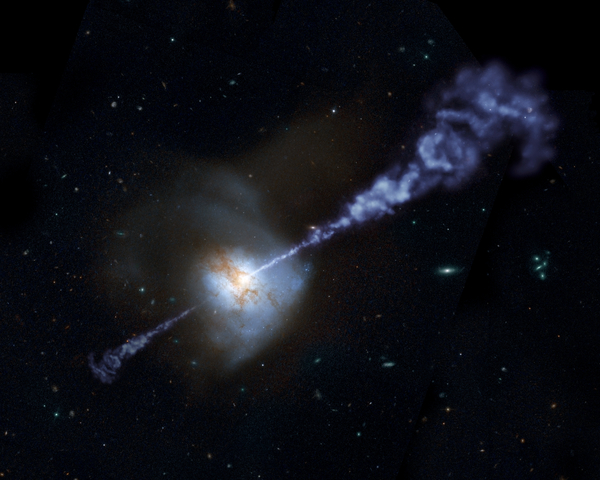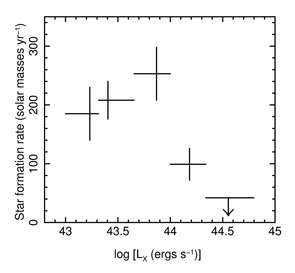The most powerful black holes quenched their galaxy's star formation
10 May 2012
A survey of galaxies performed with ESA's Herschel Space Observatory has shown that only the most powerful black holes in the early Universe were able to quench the formation of stars in their host galaxies. This finding is an important contribution to our understanding of one of the most hotly debated phases of galaxy evolution.The first galaxies in the history of the Universe started to form a few hundred million years after the big bang. At this very early epoch in cosmic history, galaxies were quite different to those that are now observed in the local Universe. Early galaxies produced stars at tremendous rates and the supermassive black holes residing at their centres were exceptionally active in accreting the surrounding matter.
 |
| Artist's impression of galactic outflows. Credit: NASA/JPL-Caltech/R. Hurt |
Galaxy surveys performed across the electromagnetic spectrum indicate that both activities – star formation and black hole accretion – were most intense when the Universe was only a few billion years old, and that this later declined to the moderate rates observed in local galaxies. Although the two phenomena appear to be linked, it is still unclear to astronomers whether a black hole's activity is more effective at triggering or at quenching the production of stars in its host galaxy. These crucial phases in the early evolution of galaxies are still hotly debated and the subject of extensive investigations.
A new study, led by Mathew Page from the Mullard Space Science Laboratory (UK), has now brought a valuable and unexpected piece of evidence to the debate, showing that star formation did indeed fade out significantly in the galaxies that, at early cosmic times, hosted the most active black holes. The study is based on an analysis of two patches of the sky that have been observed at far-infrared and sub-millimetre wavelengths with ESA's Herschel Space Observatory and in X-rays with NASA's Chandra X-ray Observatory. The results are reported in the 10 May 2012 issue of the journal Nature.
"We used Herschel to seek the signature of star formation in a sample of galaxies that are known, from X-ray observations, to host active black holes," explains Page. With its spectral coverage ranging from far-infrared to sub-millimetre wavelengths, Herschel is an ideal tool to quantify a galaxy's star-forming activity. In fact, galaxies that are fiercely producing stars shine brightly in the spectral portion probed by Herschel, as a significant fraction of the light emitted by their stars is absorbed by interstellar dust and radiated again at these longer wavelengths. The Herschel data used in this study are part of the Herschel Multi-tiered Extra-galactic Survey (HerMES), a project designed to probe galaxy evolution at high redshift.
In particular, Page and his collaborators focussed on the cosmic epoch when the Universe was two to six billion years old; in order to do so, they singled out the galaxies in their sample with redshifts between 3 and 1. During this period, galaxies underwent the most intense activity in terms of both their star formation and accretion of matter onto their central black holes. The astronomers analysed how a galaxy's star formation rate, inferred from the Herschel data, correlates with its brightness in X-rays, which is an indicator of the black hole's activity.
 |
| The most powerful black holes shut off star formation in their host galaxies. Image courtesy of Mathew Page, Mullard Space Science Laboratory, UK |
"Surprisingly, we identified two distinct trends in the data," comments Page. Below a certain threshold, the astronomers noted a correlation between black hole activity and star formation: galaxies hosting more active black holes do form stars at a higher rate. However, this correlation does not hold for the galaxies that harbour the most powerful black holes: in these objects, star formation appears to proceed at very moderate rates. "Something must have shut off the star formation in these galaxies – most likely the very intense activity of the central black hole," adds Page.
Astronomers had long suspected that black holes could exert such negative feedback on their host galaxy: the accretion process of matter onto a black hole is not completely efficient and can thus drive large amounts of the galaxy's interstellar matter outwards. These black-hole triggered winds would then deprive galaxies of the raw material needed to form stars. In recent years, evidence has mounted in support of this scenario; among others, a survey of galaxies performed with Herschel has shown, in 2011, that galactic outflows are indeed able to influence the entire galaxy's star formation.
The study of Page and his colleagues not only confirms this picture, but also adds a quantitative element to it: only the most powerful among black holes – those characterised by X-ray luminosity exceeding 1044 erg/s – are able to quench the star formation taking place in their host galaxies. "We are very thrilled to have identified such a threshold, although the exact mechanisms that set it are still unclear," notes Page. "A deeper understanding of these phenomena will come only from further observations of the galaxies that host these extremely powerful black holes, which we plan to study in great detail using data from ESA's XMM-Newton X-ray Observatory," he adds. With its larger field of view and effective area, XMM-Newton has covered a wider portion of the sky and provided higher quality spectra with respect to Chandra. Combining these data with the Herschel survey will allow the astronomers to probe an even larger number of galaxies where the central black holes have quenched stellar formation.
"This result showcases the quality and importance of the large surveys that are currently being undertaken with Herschel and its ability to probe one of the most intriguing phases of galactic evolution," comments Göran Pilbratt, Herschel Project Scientist at ESA.
Notes for editors
The study relies on data acquired with ESA's Herschel Space Observatory at sub-millimetre wavelengths, and with NASA's Chandra X-ray Observatory in X-rays. The data are from observations of the Chandra Deep Field North, a patch of the sky measuring 0.07 square degrees, complemented by a shallower survey of the Extended Chandra Deep Field South, a larger field measuring 0.28 square degrees.
The Herschel data have been acquired with the SPIRE instrument on board Herschel as part of the Herschel Multi-tiered Extra-galactic Survey (HerMES), a Guaranteed Time Key Programme designed to probe galaxy evolution at high redshift. HerMES is the largest Herschel Key Programme in terms of observing time and aims at studying the evolution of galaxies in the distant Universe. The project is carried out by a large international collaboration led by Seb Oliver (University of Sussex, UK) and Jamie Bock (Caltech, USA).
Herschel is an ESA space observatory with science instruments provided by European-led Principal Investigator consortia and with important participation from NASA. The SPIRE instrument contains an imaging photometer (camera) and an imaging spectrometer. The camera operates in three wavelength bands centred on 250, 350 and 500 µm, and so can make images of the sky simultaneously in three sub-millimetre colours.
SPIRE has been developed by a consortium of institutes led by Cardiff Univ. (UK) and including Univ. Lethbridge (Canada); NAOC (China); CEA, LAM (France); IFSI, Univ. Padua (Italy); IAC (Spain); Stockholm Observatory (Sweden); Imperial College London, RAL, UCL-MSSL, UKATC, Univ. Sussex (UK); Caltech, JPL, NHSC, Univ. Colorado (USA). This development has been supported by national funding agencies: CSA (Canada); NAOC (China); CEA, CNES, CNRS (France); ASI (Italy); MCINN (Spain); SNSB (Sweden); STFC (UK); and NASA (USA).
Related publication
M. Page, et al., "The suppression of star formation by powerful active galactic nuclei", 2012, Nature, 485, 213. DOI:10.1038/nature11096
Contacts
Mathew Page
Mullard Space Science Laboratory
University College London, UK
Email: mjp mssl.ucl.ac.uk
mssl.ucl.ac.uk
Phone: +44-1483-204283
Göran Pilbratt
Herschel Project Scientist
Research and Scientific Support Department
Science and Robotic Exploration Directorate
ESA, The Netherlands
Email: gpilbratt rssd.esa.int
rssd.esa.int
Phone: +31-71-565-3621


